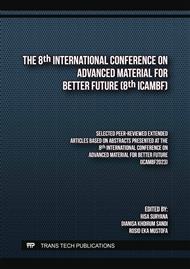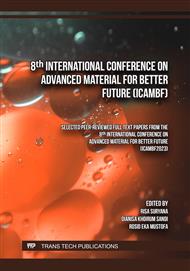[1]
A. Chahyadi, R. Hartati, K.R. Wirasutisna, Boesenbergia pandurata Roxb., an Indonesian medicinal plant: Phytochemistry, biological activity, plant biotechnology, Procedia Chem. 13 (2014)13-37.
DOI: 10.1016/j.proche.2014.12.003
Google Scholar
[2]
C. W. Lee, H. S. Kim, H. K. Kim, J. W. Kim, J. H. Yoon, Y. Cho, Inhibitory Effect of Panduratin A Isolated from Kaempferia panduarata Roxb. on Melanin Biosynthesis, Phytother Res. 1604 (2010) 1600–1604.
DOI: 10.1002/ptr.3163
Google Scholar
[3]
S. Kumar, A. K. Pandey, Chemistry and Biological Activities of Flavonoids : An Overview, Sci. World J. 2013 (2013) 1-17.
Google Scholar
[4]
L. E. Alcaraz, S.E. Blanco, O. N. Puig, F. Tomas, F. H. Ferretti, Antibacterial Activity of Flavonoids Against Methicillin-resistant Staphylococcus aureus strains, J. Theor. Biol. 205 (2000) 231–240.
DOI: 10.1006/jtbi.2000.2062
Google Scholar
[5]
K. Lee, H. M. Sun, K. T. Kim, A. F. Mendonca, H. D. Park, Antimicrobial Effects of Various Flavonoids on O157: H7 Cell Growth and Lipopolysaccharide Production, Food Sci. Biotechnol. 19 (2010) 257–258.
DOI: 10.1007/s10068-010-0037-7
Google Scholar
[6]
L. Padilla-Campos, R. A. Zarate, Electronic and structural properties of 5-hydroxy-7-metoxyflavanon: A theoretical approach, J. Chil. Chem. Soc. 61 (2016) 3267–3272.
DOI: 10.4067/s0717-97072016000400023
Google Scholar
[7]
G. K. Mukusheva, A. Lipeeva, P. Zhanymkhanova, E. Shults, Y. Gatilov, M. Shakirov, S. Adekenov, The flavanon pinostrobin in the synthesis of coumarin-chalcone hybrids with a triazole linker. Chem. Heterocycl. Compd. 51 (2015) 146–152.
DOI: 10.1007/s10593-015-1672-y
Google Scholar
[8]
S. D. Marliyana, D. Mujahidin, Y. M. Syah, Pinostrobin Derivatives from Prenylation Reaction and their Antibacterial Activity against Clinical Bacteria, IOP Conference Series: Mater. Sci. Eng. 349 (2018) 1-6.
DOI: 10.1088/1757-899x/349/1/012057
Google Scholar
[9]
L.G. Sarbu, L.G. Bahrin, C. Babii, M. Stefan and M.L. Birsa, Synthetic flavonoids with antimicrobial activity: a review. J. Appl. Microbiol. 127 (2019) 1282-1290.
DOI: 10.1111/jam.14271
Google Scholar
[10]
Y. Xie, W. Yang, F. Tang, X. Chen, L.Ren, Antibacterial Activities of Flavonoids: Structure- Activity Relationship and Mechanism, Curr. Med. Chem. 22 (2014) 132–149.
DOI: 10.2174/0929867321666140916113443
Google Scholar
[11]
A. Foroumadi, N. Mohammadhosseini, S. Emami, B. Letafat, Full Paper Synthesis and Antibacterial Activity of New 7-Piperazinyl- quinolones Containing a Functionalized 2- (Furan-3-yl) ethyl Moiety, Archiv der Pharmazie. 340 (2007) 47–52.
DOI: 10.1002/ardp.200600169
Google Scholar
[12]
Y. N. Mabkhot, F. Alatibi, N. N. E. El-Sayed, S. Al-Showiman , N. A. Kheder, A. Wadood , A. Rauf, , S. Bawazeer, T. B. Hadda , Antimicrobial Activity of Some Novel Armed Thiophene Derivatives and Petra/Osiris/Molinspiration (POM) Analyses, Molecules. 21 (2016) 222-238.
DOI: 10.3390/molecules21020222
Google Scholar
[13]
World Health Organization. Antibiotic Resistance. 2023. Available online: https://www.who.int/news-room/fact-sheets/detail/antibiotic-resistance (accessed on 6 Mei 2024).
Google Scholar
[14]
S.D. Marliyana, M. Firdaus, M. W. Wartono, U. W. Apriani, D. I. Utami, Chemical Modification of Pinostrobin from The Rhizome of Kaempferia Pandurata Roxb. Through Ethylation and Allylation Reactions, Chem. Nat. Comp. 60 (2023) 1026-1033.
DOI: 10.1007/s10600-023-04197-z
Google Scholar
[15]
C. Babii, G. Mihalache, L.G. Bahrin, A.N. Neagu, I. Gostin, C.T. Mihai, L.G. Sarbu, L.M. Birsa, M. Stefan, A novel synthetic flavonoid with potent antibacterial properties: in vitro activity and proposed mode of action. PLoS ONE 13 (2018) 1-15.
DOI: 10.1371/journal.pone.0194898
Google Scholar
[16]
O. O. Olajuyigbe, A. J. Afolayan, In Vitro Antibacterial and Time-Kill Assessment of Crude Methanolic Stem Bark Extract of Acacia mearnsii De Wild against Bacteria in Shigellosis, Molecules. 17 (2012) 2103-2118.
DOI: 10.3390/molecules17022103
Google Scholar
[17]
N. F. Shamsudin, Q. U. Ahmed, S. Mahmood, S. A. A.Shah , A.Khatib, S. Mukhtar, M.A. Alsharif, H. Parveen and Z. A. Zakaria, Antibacterial Effects of Flavonoids and Their Structure-Activity Relationship Study: A Comparative Interpretation. Molecules 27 (2022) 1149-1191.
DOI: 10.3390/molecules27041149
Google Scholar
[18]
N. S. H. N. Moorthy, R. J. Singh, H. P. Singh, S. D. Gupta, Synthesis, Biological Evaluation and In Silico Metabolic and Toxicity Prediction of Some Flavanone Derivatives, Chem. Pharm. Bull. 54 (2006)1384–1390.
DOI: 10.1248/cpb.54.1384
Google Scholar
[19]
T. Y., Li, Q. Wang, K. S. Bi, Bioactive flavonoids in medicinal plants: Structure, activity and biological fate, Asian J. Pharm. Sci. 13 (2018)12-23.
DOI: 10.1016/j.ajps.2017.08.004
Google Scholar
[20]
M.S. Olivella, V.E.P. Zarelli, N.B. Pappano, N.B. Debattista, A comparative study of bacteriostatic activity of synthetic hydroxylated flavonoids. Braz J Microbiol 32 (2001) 229–232.
DOI: 10.1590/s1517-83822001000300013
Google Scholar
[21]
H.P. Ávila, E.D.F.A. Smânia, F.D. Monache, A. Smânia, Structure–activity relationship of antibacterial chalcones. Bioorg. Med. Chem. 16 (2008) 9790–9794.
DOI: 10.1016/j.bmc.2008.09.064
Google Scholar
[22]
S. Manner, M. Skogman, D. Goeres, P. Vuorela, A. Fallarero, Systematic exploration of natural and synthetic flavonoids for the inhibition of Staphylococcus aureus biofilms. Int J Mol Sci. 14 (2013) 19434–19451.
DOI: 10.3390/ijms141019434
Google Scholar
[23]
J. Kozlowska, E. Grela, D. Baczynska, A. Grabowiecka, M. Aniol, Novel O -alkyl Derivatives of Naringenin and Their. Molecules. 24 (2019) 1–15.
Google Scholar



